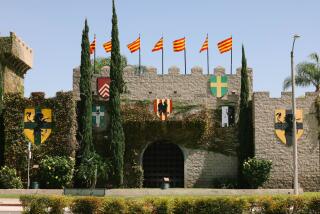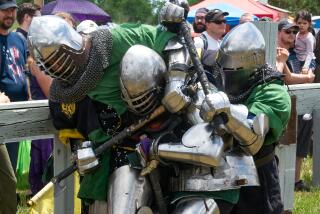Anachronism Society Offers Its Fealty to Age of Knights and Ladies
- Share via
Ed Cathell fondly remembers the day he was knighted as one of the proudest moments in his life.
He had spent long years as a lowly squire in the service of another knight. He had acquired his own set of armor, helmet and sword; he learned the code of chivalry and he practiced fighting religiously. But he had all but given up his hope of ever becoming Sir Edward.
“One day when I came off the practice field, I was told my knight was looking for me and he wants to see me right now, and he’s upset. And I think, ‘Oh no,’ ” Cathell remembers with a smile.
He quickly found his knight, who pulled out a dagger and sliced it through Cathell’s squire belt, letting it fall to the ground unceremoniously.
“I’ve talked to the king about this, and you no longer deserve to be my squire,” the knight told him.
Edward’s heart sank. He wondered what he could possibly have done to displease his master. But as the knight sauntered away, he turned back and tossed Cathell a pillow case. “Here, you might need this,” he told the confused ex-squire. Inside the pillow case was a knight’s white caftan, the badge of honor for a new peer of the realm. “Congratulations. You made it, boy,” the knight said.
Welcome to the medieval world of the Society for Creative Anachronism.
Hundreds of people from across Southern California left behind the County of Orange Saturday and entered the Barony of Gyldenholt. For a day, Boysen Park in Anaheim became a world unto itself, with all the romance and gallantry of the Middle Ages as Gyldenholt celebrated its sixth anniversary as a barony.
“What makes the SCA special to me is the dream,” said Cathell, a 33-year-old engineer who has since captured the throne and is now Edward, king of Caid. “The dream of chivalry, the dream of courtesy, of being yourself, following your inner-bred ideas--the knightly virtues--to their ultimate conclusion of being a good person.”
For the thousands of enthusiasts nationwide, this isn’t some children’s game where you can simply put a crown on your head and declare yourself a member of the nobility. This is a serious group, where a title and the privilege of being addressed as lord or lady are earned the old-fashioned way--through lots of hard work.
“You spend 20 hours a week, for four, five, six, seven years,” King Edward tries to explain to an outsider. “I’d given up even hoping to get it (my knighthood). It was one of those things you work for and work for and work for, and finally convince yourself you don’t deserve it. . . . Yes, it means a lot .”
Across the park filled with armored knights clashing with wooden swords is the mistress, the baroness of Gyldenholt.
“For me, the most important part is seeing people come in for a peripheral interest in something, martial arts or Dungeons and Dragons or something of that nature, and begin to associate with us and start to develop a persona,” says Baroness Rosemary Willowwood. “And suddenly the interest begins to come up in history and culture and interrelations of societies and how the development of countries fits into modern times.”
A former Irvine police officer and medieval English literature major, the baroness (actually Susan Torkelson) stumbled upon an event at UC Irvine almost five years ago and decided to satiate her curiosity. Today she is mistress of the Barony of Gyldenholt (literally “golden groves”) and its 85 members.
‘We Have an Ideal’
“It’s the same as the Kiwanis in that we take people with very diverse backgrounds and give them a common interest where they can interact socially,” she says. “It is similar to the Rotary in that we have an ideal. . . . We have the dream of re-creating the chivalry, the pageantry, the courtesy of the Middle Ages.”
As she speaks, one knight rubs her shoulders and another her feet as part of the “Please the Baroness contest.”
“They always ask permission, even to come into your sunshade. They ask permission to touch personal items. They call you ‘my lord’ or ‘my lady.’ It’s please and thank you everything . . . and that tends to spill over into our regular lives.”
The society was first conceived in 1966 when science-fiction writer Diana Paxton held a successful May Day medieval celebration at UC Berkeley.
Then they were radical, flower-power history students. They were considered hippies, crazy teen-agers, eccentrics. Twenty years later, the society has mushroomed into a huge, multigenerational organization with members across the globe divided into 12 “kingdoms.” There are more than 10,000 registered members in fiefs all over the United States, England, France, Germany, Sweden, Japan, Australia and New Zealand. Even the Navy aircraft carrier Nimitz is a floating barony.
The Kingdom of Caid (pronounced Ky-EED ) encompasses all of Southern California, with Fresno on the northern border. It also includes the barony of New Zealand because “we wrote them the nicest letter.”
King Edward rules Caid by right of arms. That is, he earned the throne when he beat out all competitors at the Crown Tourney several months ago. He was crowned in an elaborate ceremony May 31, and he will rule for six months.
His successor will lead the kingdom in the annual Estrella War held outside Phoenix during President’s Day weekend each February, when Caid meets the Kingdom of Adenveldt on the field of battle. As many as 500 men and women clad in armor and bearing weapons may be fighting at any one time. It is the biggest event of the year for both kingdoms.
Just last month, however, the warriors and artisans from Caid traveled to Pasadena, Tex., for the society’s largest event ever, a 20th-anniversary celebration that included thousands of medievalists from around the world.
Of course, with 11 monarchs present, there was bound to be some diplomatic dilemma, such as when the queen of the West, nine months pregnant, gave birth to a baby boy during the 10-day affair.
Dispute Over Citizenship
“This caused a great dispute . . . because the people of the kingdom where the event took place claimed the baby as a citizen, but of course the king and queen of the West insisted he was a citizen of the Kingdom of the West,” recalled Baroness Rosemary. “Well, to resolve the dispute, they finally declared the child to be a ‘citizen of the Known World.’ ”
Over the last two decades, the society has become quite Establishment. It has its own bureaucracy, its own politics and its own detailed rules. There is even a magazine now called Tournaments Illuminated that features such articles as “Traditional Celtic Music” and “Fishing Forsoothly.”
Newcomers to the society must shed their “mundane” names and adopt a “persona,” or fictional medieval character for the events.
Most members know each other only by their society names and are sometimes surprised when a medievalist friend is referred to by a 20th-Century name such as John Smith. Names are registered with the group to prevent duplication, but everyone is free to develop an intricate and involved life history for their persona, sometimes involving painstaking research over a period of months.
Imaginative History
Orange County’s baroness of Gyldenholt, for instance, went into hiding with her mother when her father was killed during a 13th-Century English uprising. At 10, she was betrothed to a man who was later killed. In order to prevent being married off against her will, she disposed of her dowry and joined a Benedictine nunnery in Buxton at the headwaters of the Mersey River. Baroness Rosemary tells this tale so easily, that for a moment an outsider is half-convinced it is true.
Not all is so intense, however. The society often indulges in whimsy.
For example, Saturday’s event featured a boasting contest, which is exactly what it implies, and a “Steal the Cow” contest where participants try to filch a stuffed cow during the day without being caught. Supposedly the latter is based on Celtic folklore, but it seemed more a product of silly fun than historical re-creation.
The group certainly also lives up to its legacy of anachronism rather well. In the middle of announcing the contestants of Saturday’s third round, a herald was forced to pause while a noisy and distinctly non-medieval helicopter passed overhead. And it wasn’t often you would see the real King Arthur sipping on a can of Classic Coke or checking his digital watch.
And where else would you find a man wearing a machine-produced T-shirt that said “Battle of Hastings 1986--Normans 1, Saxons 0”?
Of course, outsiders sometimes react strangely to the society’s sometimes outlandish ways.
“People would ask me, ‘what are you doing for the weekend?’ and I’d say, ‘oh, I’m going to a war in Arizona,’ ” recalls Baroness Rosemary. She laughs, but her colleagues didn’t.
Mistaken Identity
Another noble remembered a recent tourney when somebody had forgotten a few items for the feast, so she and several other ladies of the court skipped over to the local grocery store.
“On the way out, we’re standing in the checkout line being perfectly normal, ordinary, everyday people wearing funny clothes,” says Baroness Catriona NuChlurain (Beth Moberly), a lady-in-waiting. “And some woman comes up behind us and says, ‘Damn people ought to be kept out of this place. How dare they!’ We finally found out she thought we were part of some strange religious cult.”
But even though customers at a local McDonald’s will still stare when a Norman viscount in full regalia comes in to order a Big Mac and French fries, the society has become recognized. Occasionally, complete strangers will approach someone in costume to ask, “are you SCA?”
But while a lot of people have heard of the medievalists, most associate them with only their most glamorous aspect: fighting. Few realize that members also participate in medieval costuming, spinning, weaving, armory, needlework, orchestras, choirs and a historian’s guild.
“I wanted to be an artist, but I finally realized I had no talent for it,” says Andrea Harabedian, known as Lady Angela of Rosebury, head of the scribe’s guild. “But with this I still get to do it, really. You shouldn’t ask, I’ll go on forever and ever about scrolls.”
Harabedian, who is studying at UC Fullerton, spends long afternoons in the library researching her craft, plus countless hours preparing paints and parchment for the scrolls the kingdom needs. The average scroll takes her about eight hours to complete, and she takes a certain pride in a carefully crafted piece.
Bardic Guild
“Basically in the Middle Ages, bardic arts were the entertainment,” explains Carl Anderson, a bardic poet known as Thoron Ravenoak. “It was the TV and the radio. On a cold, wintry day, all they could do was sit around the fire and listen to the bard. It was extremely important back then and we’re trying to convey that today.”
Anderson, who is researching Viking-style poems, is a member of the barony’s bardic guild, which meets once a month to read, sing and critique member’s poems.
“When you first see a tournament, you see all the smashing and bashing, but that’s just on the superficial level,” he reflects. “You don’t see all the other things going on beneath the surface. There’s a lot more to the society than just hitting each other with sticks.”
Jim Tibbetts, 31, has degrees in biology and chemistry and is working on his master’s degree in computer science. Days, he works as a software test engineer for Hughes Aircraft in Fullerton, but nights and weekends he spends as a 12th-Century Celtic silver worker and master musician for the Barony of Gyldenholt.
Known as Master Ambrose Celidonis, he is an accomplished musician who plays recorder, harp and occasionally the lute. He also crafts silver and personally made the king’s crown. The coronet he fashioned for himself has a 9th-Century chant in original notation around the outside. It took 40 hours to make.
His crowning experience, however, was the translation and performance of a 12th-Century opera called “The Play of Daniel.”
First Performance in Ages
After receiving microfilm copies of the original manuscripts from the British National Library, Tibbetts spent 11 months transcribing it and seven months preparing for a fully staged performance that he and 45 others presented at churches in Santa Ana and Costa Mesa.
According to the British library, his was only the third performance of that opera since it fell out of favor in 1610.
“It’s very rewarding to go through a performance like that, even with all the headaches,” he says, proud to regale strangers with that accomplishment.
Once you have felt that satisfaction, once you’ve had a taste of life in the Middle Ages--albeit a more sanitary version--members say you never turn back.


